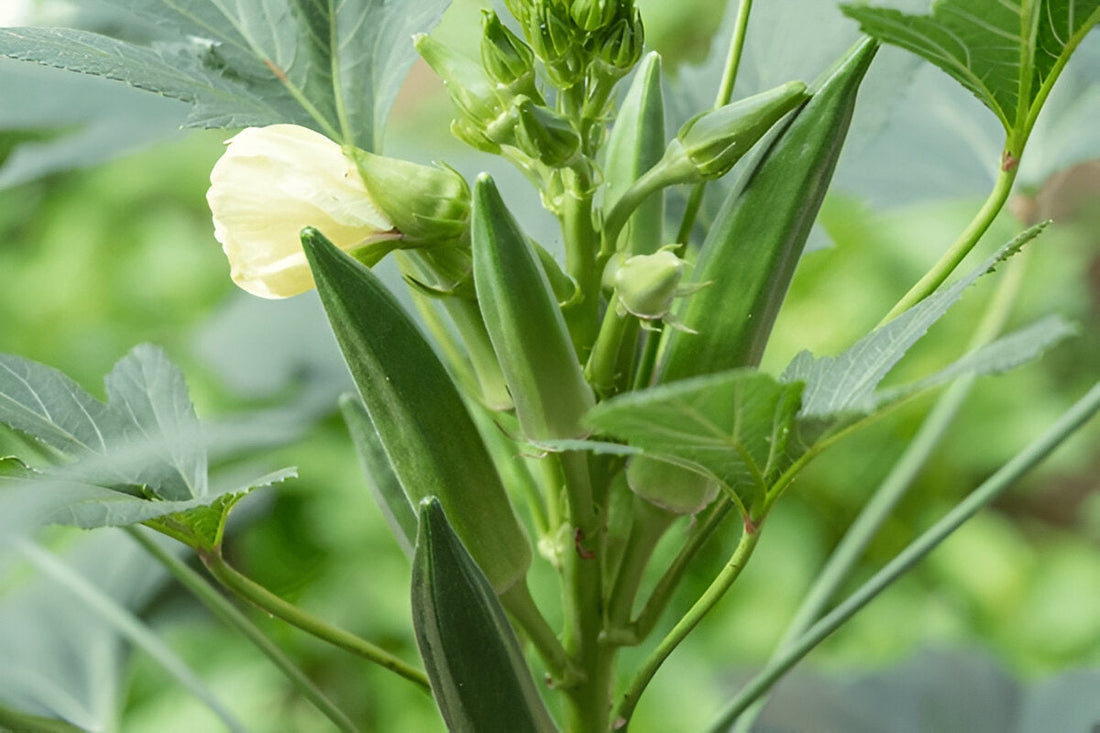
Growing Okra in Pakistan – Detailed Guide
Share
Growing okra (بھنڈی) at home is simple and very rewarding, especially in Pakistan’s warm climate. With a little care and sunshine, you can enjoy a continuous supply of tender, healthy bhindi for curries, stir-fries, and more. Here's an easy guide to grow fresh okra successfully at home.
| Aspect | Details |
|---|---|
| Best Sowing Time | February to June |
| Ideal Temperature | 24°C to 32°C |
| Germination Time | 5–10 days |
| Transplant Time | 2–3 weeks after sowing |
| Spacing | 12–18 inches between plants |
| Harvest Time | 50–70 days after sowing |
Step 1: Sow Seeds 🌱
When to Sow:
- Sow seeds from February to June, when warm weather helps quick growth.
- Ideal soil temperature for germination is 24°C to 32°C.
- Avoid sowing in cold weather, as okra needs heat to sprout properly.
How to Sow: Soak seeds in water overnight to improve germination. Direct sow seeds 0.5–1 inch deep in soft, compost-rich soil.
Germination Tips: Seeds usually germinate in 5–10 days under warm, moist conditions. Water lightly after sowing.
Step 2: Transplant Seedlings 🌿
When to Transplant: If started in trays, transplant when seedlings have 2–3 true leaves, about 2–3 weeks after sowing.
How to Transplant: Space plants 12–18 inches apart in beds or large containers (at least 12 inches wide) to allow strong growth.
Aftercare: Water well after transplanting and protect young seedlings from heavy winds or strong afternoon sun initially.
Step 3: Care for Plants 🌞💧
Sunlight Needs: Okra needs 6–8 hours of full sunlight daily for vigorous flowering and pod production.
Watering: Water deeply 2–3 times a week, depending on weather. Let the soil dry slightly between waterings to prevent root rot.
Feeding Schedule: Mix compost into soil before planting. Apply light feeding with NPK 20-20-20 fertilizer every 15–20 days during the growing season.
Step 4: Protect Plants 🐛
Common Pests: Watch for aphids, whiteflies, and spider mites attacking leaves and stems.
Natural Protection: Spray neem oil every 10–12 days (1 teaspoon neem oil + 1 liter water + few drops soap), especially under the leaves.
Common Problems:
- Yellow Leaves: Often from overwatering or poor drainage — adjust watering practices.
- Poor Flowering: Happens in too much shade — ensure full sun exposure.
- Aphid Infestation: Neem oil spray helps control early infestations naturally.
Step 5: Harvest Pods 🎯
When to Harvest: Okra pods are ready 50–70 days after sowing, when they are about 3–5 inches long, soft, and tender.
How to Harvest: Use scissors or pinch pods off gently with your hand, being careful not to damage the main stem.
Bonus Tip: Harvest every 2–3 days to encourage more flowering and continuous pod production.
FAQs
Can I grow okra in pots?
Yes, okra grows well in large pots (at least 12 inches wide and deep) with strong sunlight.
How tall does okra grow?
Okra plants can reach 3–6 feet tall depending on the variety and growing conditions.
Why are my okra pods hard and tough?
Overgrown pods become fibrous. Always harvest pods while still young and tender.
How often should I water okra?
Water 2–3 times a week, adjusting based on heat and rainfall. Avoid overwatering.
Does okra need support?
Normally no, but taller varieties may benefit from light staking during strong winds.
Growing okra at home is easy once you match its love for warmth, full sunlight, and light watering. With steady care, you’ll enjoy a regular harvest of tender, fresh bhindi — much better than anything from the market.

